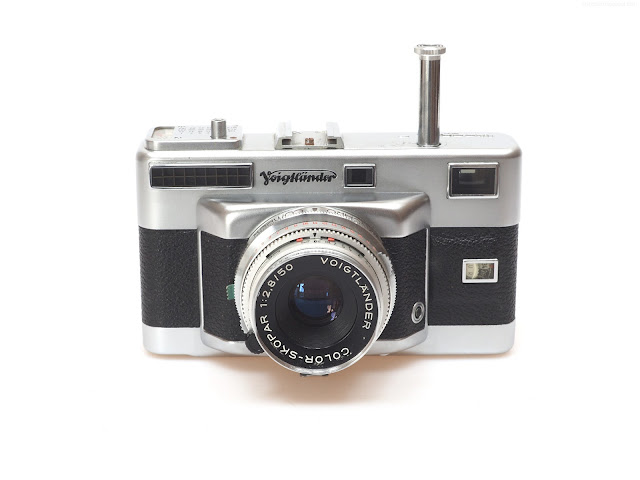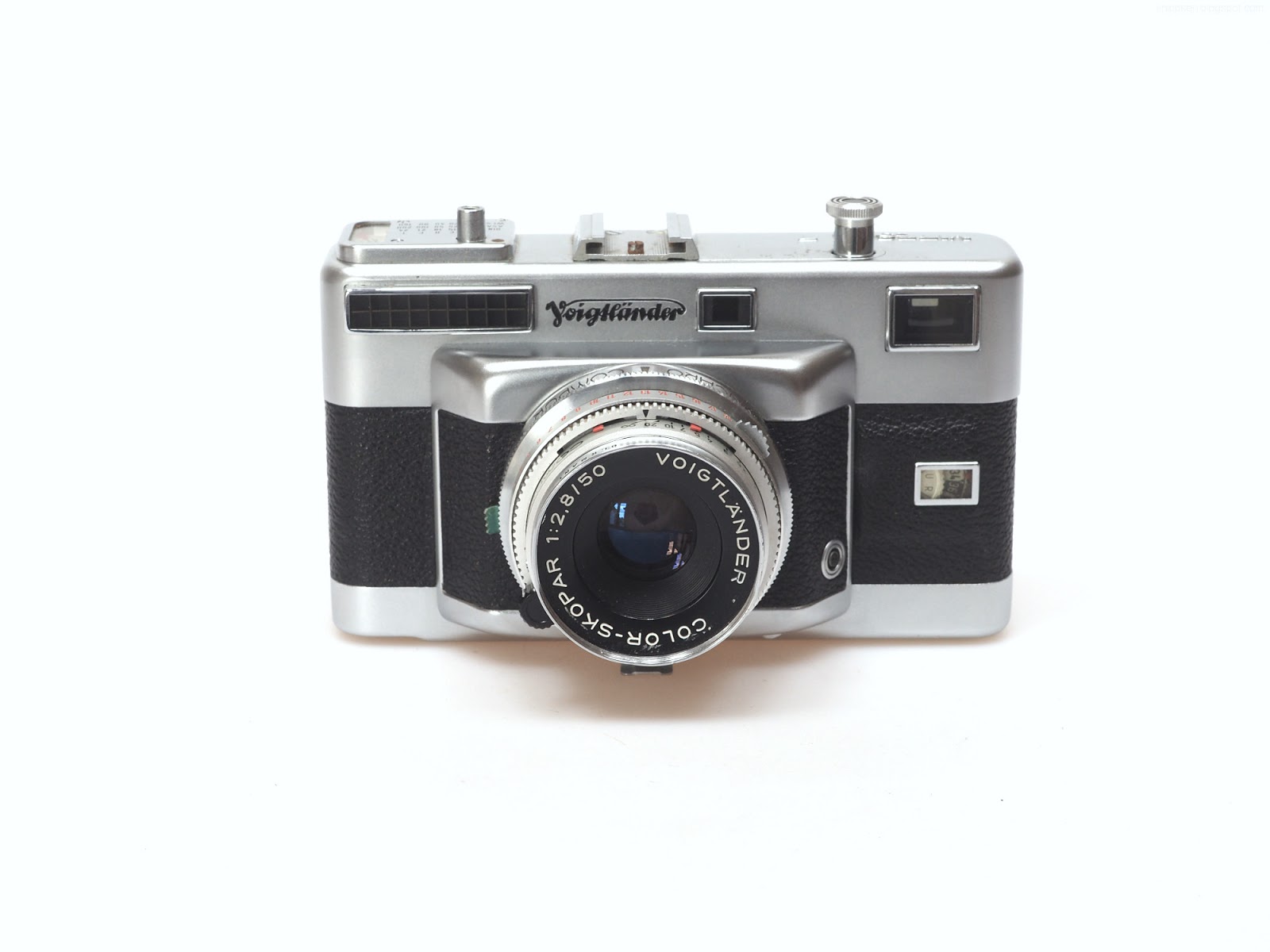Die 50er Jahre des letzten Jahrhunderts waren die Blütezeit für (Kleinbild-) Messsucherkameras. Fast jeder namhafte Hersteller hatte eine oder mehrere im Programm. Voigtländer lieferte gleich mehrere Baureihen. Auf der einen Seite die eher einfachen VITO Sucherkameras (kein Entfernungsmesser, fest eingebautes Objektiv), das andere Extrem war die High-End Systemkamera
Prominent, die den Platzhirschen
Contax und
Leica Paroli bieten sollte. Dazwischen plazierte Voigtländer 1951 die innovative
Vitessa, zunächst mit fest eingebautem aber versenkbaren High-End Objektiv (Ultron 50 mm f/2.0). Weitere Alleinstellungsmerkmale waren der automatische Parallaxenausgleich und eben die Combi-Stange (siehe unten).
The 50s of the last century were the heyday for (135 film) rangefinder cameras. Almost every manufacturer had one or more in the portfolio. Voigtlander even offered several series. On the one hand were the rather simple VITO view-finders (no rangefinder, fixed built-in lens), the other extreme was the high-end system camera
Prominent that seriously competed with the technology leaders
Contax and
Leica. Inbetween, in 1951, Voigtlander launched the innovative
Vitessa, initially with a fixed but retractable high-end lens (Ultron 50mm f / 2.0). Other unique features were the automatic parallax correction and the unique Combi-rod (see below).

Mit sehr guter Verarbeitung und einem modernen Design bei moderaten Preisen sprach man den anspruchsvollen Amateur zunächst nur im reicheren Ausland (USA) und ab 1953 auch im wachsenden Mittelstand des Wirtschaftswunder-Deutschlands an. Konsequente Modellpflege folgte und auch der 1954 eingeführte eingebaute Belichtungsmesser war mit der Lichtwertskala des neuen Synchro-Compur Verschlusses der Firma Deckel zusammen das Maß der Dinge. Komfortabler konnte man 1954 kaum fotografieren.
With excellent workmanship and a modern design at moderate prices Voigtländer adressed the demanding amateur photographer. Initially, only in wealthier countries (USA) and from 1953 on also in the growing middle class of the German "Wirtschaftswunder". Consistent facelifts followed and the Vitessa showed some benchmark technologies: the built-meter of 1954 with the light value scale in cooperation with the new synchro Compur shutter. Taking pictures more comfortably was hardly possible in 1954.

Aber der Wettbewerb um Innovation war damals extrem hoch und so musste bald wieder was neues her. Zur Photokina 1956 wurde daher dieses Topmodell Vitessa T mit Wechselobjektiven vorgestellt. Man entschied sich bei Voigtländer das
DKL Bajonett vom Verschlusshersteller Deckel/Compur zu lizensieren, die das selbe auch an Braun verkauften. Leider musste man ein paar frühere Highlights und Designelemente für das Wechselbajonett opfern, herausgekommen ist meiner Meinung nach ein eher mäßiger Kompromiss. Zum einen fehlt natürlich das "Scheunentor" und der Faltbalgen, sprich die Versenkbarkeit des Objektivs. Zum anderen aber
das hervorragende Ultron, dessen 6 Linsen einfach nicht vor den Verschluss passen. Statt dessen kam das 4-linsige Color-Skopar. Immerhin konnte man die Lichtwertskala retten und die Objektive kamen mit der automatischen Tiefenschärfeanzeige, die fast alle DKL-Objektive haben.
Hervorstechendes (im Wortsinn!) Merkmal aller Vitessa Kameras ist natürlich die Combi-Taste oder Combi-Stange, wie es sie sonst bei keiner anderen (mir bekannten) Kamera gibt. Es ist Voigtländers Interpretation des Schnellspannhebels. Combi deshalb, weil sowohl der Film transportiert als auch der Verschluss gespannt wird, in den 50ern noch keine Selbstverständlichkeit. Hält man die Kamera mit beiden Händen vors Auge, kann man tatsächlich in schneller Folge mit dem rechten Zeigefinger auslösen und mit dem linken spannen. Leider fehlt einem nur die dritte Hand zum Scharfstellen (die ursprünglichen Vitessas hatten hier ein Rad für den rechten Daumen!). Hat man einmal gespannt, kann man die Combi-Taste beliebig oft wieder drücken ohne das etwas passiert. Das ist auch nötig, weil sie ausgefahren (nur dann ist die Kamera schussbereit) doch ziemlich ab- und im Wege steht und man sie ja auch wieder in Parkposition schieben können muss. Das mit dem "im Wege" betrifft z.B. größere Blitzgeräte oder anderes für den Zubehörschuh, die entsprechend nicht verwendet werden können. Die Tatsache, dass die Combi-Stange bei keinem weiteren Kameradesign Verwendung fand, zeigt ihre Unterlegenheit gegenüber dem damals aufkommenden Schnellschalthebel, wie wir ihn von vielen anderen Kameras kennen.
The oustanding (literally!) feature of all Vitessa cameras is of course the Combi button or Combi rod, as it does not exist with any other camera (known to me). It is Voigtlaenders interpretation of the quick-release lever. "Combi" because both, the film is advanced and the shutter is cocked. During the 50s this was still not self-evident. If you hold the camera with both hands to the eye, you can actually shoot with the right index finger and advance with the left one in quick succession. Unfortunately, there is only a third hand missing to focus (the original Vitessas had a wheel for the right thumb!). Once you have cocked/advanced you can press the Combi button any number of times without anything happening. This is necessary, because if extended (only then the camera is ready to shoot) it is quite in the way and sometimes you have to be able to slide it into the park position. This "in the way" refers to some bigger flash units or other items for the accessory shoe, which can not be used accordingly. The fact that the Combi-rod was never re-used in any other camera design, shows its inferiority compared to the then emerging quick-release lever, as we know it from many other cameras.
Die Vitessa T aber ist die letzte Voigtländer mit Combi-Stange und bleibt mit nur ca. 3 Jahren Bauzeit ein Übergangsmodell. Denn 1958 (endlich) kommt mit der
Bessamatic die erste Spiegelreflex des Hauses (die
Contaflex von Zeiss und auch
Kodak's Retina Reflex waren schon auf dem Markt). Die Bessaflex hatte ebenfalls ein allerdings etwas anderes DKL-Bajonett. Es ist wohl dieselbe Zielgruppe, die nun zur SLR greift und der Kunde ist halt König. Insgesamt wurden fast 300.000 Vitessas gebaut, eigentlich keine schlechte Zahl für die damalige Zeit. Wer noch mehr erfahren will, dem sind die Links unten in der Tabelle empfohlen.
Hence. the Vitessa T is the last Voigtländer with a Combi-rod and with only about 3 years of production time it remains a transition model. In 1958 (finally!) the
Bessamatic is launched, the first reflex of the house (the
Contaflex of Zeiss and
Kodak's Retina Reflex were already on the market). The Bessaflex also had a somewhat different DKL mount. It is probably targeting the same market group, which now considers a SLR rather than a rangefinder. A total of about 300,000 Vitessas were built, not a bad number for that time. Anyone who wants to learn more, please see the links in the table below.
Ich habe jedenfalls ein echtes Schnäppchen gemacht, die Kamera funktioniert samt Belichtungsmesser und ich werde in Kürze den Praxistest machen und hier natürlich berichten.
I have certainly made a real bargain, the camera works including the light meter and I will make a practical test soon and report about here of course.
| Datenblatt |
KB-Messsucherkamera für Wechselobjektive |
| Objektiv(e) |
Wechselobjektive in spezieller DKL-Fassung. Von Voigtländer erhältlich waren neben dem Standard Color-Skopar 1:2,8/50 mm das Weitwinkel Skoparet 1:3,4/35 mm sowie die Teleobkejtive Dynaret 1:4,8/100 mm und Super Dynaret 1:4,0/135 mm. Ansonsten passten die Objektive zur Braun Colorette II. |
| Verschluss |
Synchro-Compur Zentralverschluss hinter dem Objektiv. B, 1-2-4-8-15-30-60-125-250-500 mit Lichtwertkupplung |
| Belichtungsmessung |
Eingebauter, ungekuppelter Selenbelichtungsmesser, ASA 6-200 mit Lichtwertanzeige |
| Fokussierung |
Manuell am Objektiv, gekuppelter Messsucher-Entfernungsmesser |
| Sucher |
Messsucher, Ausschnitt und automatischer Parallaxenausgleich für Normalobjektiv. Für andere Objektive musste ein Aufstecksucher verwendet werden. |
| Blitz |
M oder X umschaltbar, Anchluss über Buchse. |
| Filmtransport |
Mit sog. Combi-Stange, Schalter für Filmtransport ohne Auslösung, Rückspulkurbel, Bildzählwerk. |
| sonst. Ausstattung |
Selbstauslöser, mechanisch gekuppelte Tiefenschärfeanzeige an jedem Objektiv, Stativgewinde, Zubehörschuh, ISO-Gewinde für Drahtauslöser, |
| Maße, Gewicht |
85x135x75 mm, 785 g (mit Normalobjektiv) |
| Batterie |
keine |
| Baujahr(e) |
1956-1960, ca. 42,000 Exemplare, diese #11-16306 vermutlich 1957. |
| Kaufpreis, Wert heute |
398 DM (mit Normalobjektiv), ca. 100-200 € je nach Zustand. |
| Links |
Lausch, Bleckedermoor, Schoebels, Udo Afalter, Hans Lißberger, Bedienungsanleitung (engl.), Camera-wiki, |
| Data Sheet |
Rangefinder camera with interchangeable lenses for 135 film |
| Lens |
Lenses with special DKL mount. Voigtländer offered the standard lens Color-Skopar 1:2.8/50 mm, a wide angle
Skoparet 1:3.4/35 mm, as well as the tele lenses Dynaret 1:4.8/100 mm and Super Dynaret 1:4.0/135 mm. The lenses for the Braun Colorette II fitted as well. |
| Shutter |
Synchro-Compur leaf shutter behind the lens. B, 1-2-4-8-15-30-60-125-250-500 with EV coupling. |
| Metering |
Built-in, uncoupled selenium meter, ASA 6-200 with EV (light value) display |
| Focussing |
manual at the lense, coupled rangefinder |
| Viewfinder |
Rangefinder, view and automatic parallax compensation for standard lens. For other lenses, an external viewfinder had to be used. |
| Flash |
M or X switchable, connection via socket. |
| Film advance |
With so-called. Combi-rod, switch for film transport without shutter release, rewind crank, frame counter. |
| misc. Features |
Self-timer, mechanically coupled depth of field indicator at each lens, tripod socket, accessory shoe, ISO-cable release thread, |
| Size, Weight |
85x135x75 mm, 785 g (with standard lens) |
| Battery |
no |
| Year(s) of Production |
1956-1960, about 42,000 units, this camera #11-16306 ca. 1957. |
| Original Price, Today's Value |
US$159 (398 DM), with standard lens. Today: about US$ 200 (depending on condition) |
| Links |
Lausch, Bleckedermoor, Schoebels, Udo Afalter, Hans Lißberger, Manual (engl.), Camera-wiki, |
 |
| Katalogseite aus dem "Photo Porst Photohelfer" von 1956 |
























































